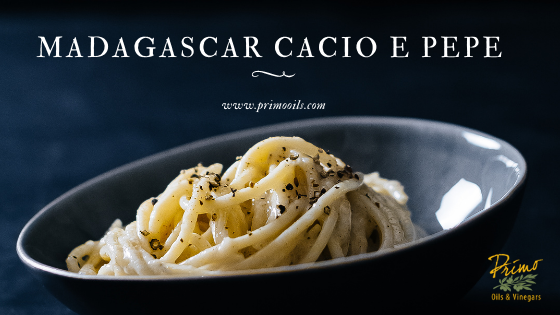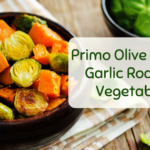There’s something about the simplicity of the Madagascar Cacio e Pepe recipe that feels both comforting and sophisticated, isn’t there? When you combine just a few ingredients—Parmesan, black pepper, pasta, and olive oil—it’s magic on a plate.
Our variation of the Madagascar Cacio e Pepe recipe, with the addition of Madagascar Peppercorn Olive Oil, takes it to a whole new level, giving you a rich, aromatic twist.
The peppercorns deliver a punch of heat, while the cheeses bring a creamy, savory richness. Together, they create a perfectly balanced dish that feels luxurious yet easy enough for any night of the week.
In this recipe, Primo Oils and Vinegars puts an exotic spin on a beloved favorite, along with step-by-step instructions and some tips to absolutely crush it while cooking this dish!
What is Madagascar Cacio e Pepe?
Cacio e Pepe is an Italian classic, a pasta dish traditionally made with just Pecorino Romano cheese, black pepper, and pasta.
It’s simple yet bold, and the twist comes in with the use of Madagascar Peppercorn Olive Oil, which infuses the dish with an earthy, peppery depth that’s a bit more exotic. The olive oil enhances the flavor of the peppercorns, bringing an irresistible richness to this already iconic dish.
Can Cacio e Pepe be made with olive oil?
Absolutely! Olive oil, particularly Madagascar Peppercorn Olive Oil, is a beautiful variation.
It provides a smooth, rich texture while enhancing the peppery flavor with a subtle fruity note. Plus, it adds a layer of sophistication and depth to the dish that is simply divine.
Ingredients for Madagascar Cacio e Pepe
Shredded Parmigiano Reggiano
For this Madagascar Cacio e Pepe recipe, we use Parmigiano Reggiano because of its nutty, rich flavor that melts beautifully into the sauce.
It’s the heart of this dish, adding that creamy, savory depth. Make sure to grate it fresh—pre-shredded cheese just won’t melt as smoothly.
Powdered Parmesan
The powdered Parmesan helps to create a smoother sauce that clings perfectly to the pasta. While it may seem like a simple addition, it balances out the richness of the Parmigiano Reggiano and contributes to the creamy texture.
Peppercorns
Freshly cracked black pepper is key to this dish. Madagascar peppercorns, in particular, bring an earthy, aromatic spice with just a hint of fruitiness.
Toasting the peppercorns before grinding enhances their flavor and adds depth to the sauce. This step is completely optional, but it releases its oils and makes it a smokier, spicier, and more enjoyable addition to your dish.
Madagascar Peppercorn Olive Oil
We love using Madagascar Peppercorn Olive Oil in this recipe because it infuses the dish with an extra layer of flavor that complements the peppercorns. The fruity and slightly spicy notes of this olive oil bring a unique twist to a classic dish.
Salt & Pepper to Taste
While the peppercorns and olive oil already bring plenty of flavor, a pinch of salt helps to bring everything together. Add salt to taste as you go to ensure the right balance.
How to Make Madagascar Cacio e Pepe
- Cook the Pasta
Start by cooking your pasta in salted water until al dente. Be sure to save about a cup of pasta water before draining—it’ll be key in creating the perfect sauce.
- Toast the Peppercorns
In a large pan, toast the peppercorns over medium heat for about 1-2 minutes, just until they release their aroma. This step really enhances the pepper’s flavor. Put your toasted peppercorns into a mill or use a mortar and pestle to grind the peppercorns.
- Assemble the Cheeses and Pepper
In a large bowl mix your two cheeses together. Add about 1 tablespoon of water and mash the cheese together with a fork. Continue to add water a little bit at a time until your cheese mixture resembles a thick paste. Add in your ground peppercorns.
- Make the Sauce
Pour just drained pasta on top of your cheese mixture. The pasta should still be hot. Using a wooden spoon vigorously mix the hot pasta noodles into the cheese mixture. Once you’ve given a couple of stirs, you can drizzle the Madagascar Peppercorn Olive Oil on top. Continue to mix the sauce until a silky texture forms. If your pasta is still too dry add reserved pasta water, about 1/4 cup at a time, to help create a smooth, velvety sauce.
- Season and Serve
Taste and adjust the salt and pepper as needed. Serve immediately, garnishing with extra cracked pepper and a sprinkle of Parmesan.
How to Serve Madagascar Cacio e Pepe
Cacio e Pepe is best served immediately while it’s creamy and warm. Pair it with a simple salad and a glass of white wine for a meal that feels indulgent without being heavy. You can also serve it as a side dish to a main course, but it’s hearty enough to stand on its own.
How to Store Leftovers
While Cacio e Pepe is best fresh, you can store leftovers in an airtight container in the fridge for up to 2 days. Reheat gently in a pan with a little olive oil or pasta water to bring back that creamy texture.
Primo’s Tips for Making this Madagascar Cacio e Pepe Recipe
- Why Make Cacio e Pepe with Fresh Pasta: Fresh pasta makes all the difference in the world when it comes to Cacio e Pepe! Not only does it have a more delicate, tender bite compared to dried pasta, but fresh pasta also absorbs the sauce more easily, giving you that smooth, creamy texture we all love.
The contrast between the slightly chewy pasta and the silky sauce is what really makes the dish pop. If you’re feeling adventurous, try making your own fresh pasta at home—it’s surprisingly easy and elevates the dish to restaurant-quality levels.
- Pasta Water: Don’t forget to save pasta water! The starch in the pasta water helps to thicken the sauce, allowing it to coat the pasta perfectly. Add it gradually after toasting the peppercorns to achieve the perfect consistency. It’s also important to make sure that your pasta water is still hot. Timing is key!
If your sauce needs a little extra help binding, add a spoonful of pasta water at a time to create a silky, smooth texture. It’s this little step that turns a simple dish into something exceptional.
- Don’t Rush the Sauce: The sauce for Cacio e Pepe is a labor of love. As you mix the cheese and pasta water, take your time. Stir constantly to ensure the cheese melts evenly and coats the pasta beautifully.
You want a smooth, velvety texture, not a clumpy or greasy sauce. Be patient, and let the pasta water and cheese come together slowly to form the perfect creamy consistency.
Madagascar Cacio e Pepe Recipe from Primo Oils
Equipment
- Pasta Pot
- A Large, Heat Safe Serving Bowl
- Tongs
- Cheese Grater
- Small skillet
- Mortar & Pestle
Ingredients
- 1/2 cup Shredded Parmigiano Reggiano
- 1/4 cup Powdered Parmesan Kraft works well.
- 1 Tbsp Peppercorns
- 1 Tbsp Madagascar Peppercorn Olive Oil
- Salt & Pepper to Taste
Instructions
- Start a large pot of water to boil. Add a good amount of salt to the water. When water boils add about half a bag of spaghetti.
- While waiting for the water to boil shred Parmigiano Reggiano into a large bowl. Add Parmesan too.
- On Medium Low heat add one tablespoon of peppercorns to small skillet. Toast until fragrant, about 1 minute.
- Using a small mortar and pestle crush the fragrant peppercorns. Add them to the bowl with the cheese.
- Add enough water to turn cheese and pepper mixture into a thick paste. About 1 to 2 tablespoons.
- When spaghetti is al dente use tongs to transfer the cooked noodles into the bowl with your cheese. You will end up transferring some of the pasta water too. This is good! You don't want too much of the pasta water but the starch in the water will help give you a nice, thick sauce.
- Drizzle a tablespoon of Madagascar Peppercorn Olive Oil on top and mix until you have a gooey, delicious dish.






